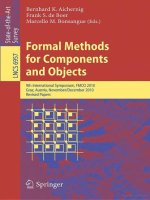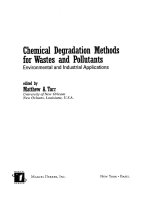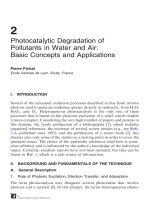Development of immersed boundary methods for isothermal and thermal flows preface
Bạn đang xem bản rút gọn của tài liệu. Xem và tải ngay bản đầy đủ của tài liệu tại đây (126.05 KB, 32 trang )
DEVELOPMENT OF IMMERSED BOUNDARY
METHODS FOR
ISOTHERMAL AND THERMAL FLOWS
REN WEIWEI
(B. Eng., M. Eng., Nanjing University of Aeronautics and Astronautics, China)
A THESIS SUBMITTED
FOR THE DEGREE OF DOCTOR OF PHILOSOPHY
DEPARTMENT OF MECHANICAL ENGINEERING
NATIONAL UNIVERSITY OF SINGAPORE
2014
DECLARATION
I hereby declare that the thesis is my original
work and it has been written by me in its entirety.
I have duly acknowledged all the sources of
information which have been used in the thesis.
This thesis has also not been submitted for any
degree in any university previously.
Ren Weiwei
2014
I
Acknowledgements
First of all, I would like to express my deepest thanks to my supervisor
Professor Shu Chang and Dr. Yang Wenming, for their continuous guidances,
supervisions and enjoyable discussions throughout this work.
In addition, I wish to thank the National University of Singapore for her
supports of the research scholarship, the abundant library resources, and the
advanced computing facilities which are essential to the completion of the
work.
The gratitude also goes to all the friends of the Fluid Dynamic Laboratory in
NUS for their valuable assistances.
Finally, I would like to thank all my family members for their endless love,
support and encouragement.
Ren Weiwei
II
Table of Contents
Acknowledgements I
Table of Contents
II
Summary
X
List of Tables
XIII
List of Figures
XV
Nomenclature
XXVI
Chapter 1 Introduction
1
1.1 Background of computational fluid dynamics 1
1.1.1 Limitations of traditional body-fitted method 2
1.1.2 The concept of non-body-conforming method 5
1.2 Non-body-conforming method 6
1.2.1 Sharp interface method 7
1.2.1.1 Ghost cell method 7
1.2.1.2 Cut-cell method 8
1.2.1.3 Immersed interface method 9
1.2.2 Diffuse interface method 10
1.2.2.1 Fictitious domain method 11
1.2.2.2 Immersed boundary method 12
III
1.3 Brief review of immersed boundary methods 14
1.3.1 Pressure-velocity formulation-based immersed boundary
method 14
1.3.2 Stream function-vorticity formulation-based immersed
boundary method 18
1.3.3 Applications of immersed boundary method 20
1.4 Objective of this thesis 24
1.5 Organization of this thesis 26
Chapter 2 Governing Equations and Boundary
Condition-Enforced Immersed Boundary Method
29
2.1 Governing equations 30
2.2 Solution procedure 31
2.3 Calculation of Predicted velocity field – Projection method 32
2.4 Evaluation of Body force 34
2.4.1 The Convectional IBM 34
2.4.1.1 Penalty force scheme 34
2.4.1.2 Feedback forcing scheme 35
2.4.1.3 Direct forcing scheme 36
2.4.2 Boundary condition-enforced IBM 37
2.5 Computational sequence 41
2.6 Results and Discussion 42
IV
2.6.1 Flow over an isolated stationary circular cylinder 42
2.6.2 Flow interference between a pair of side-by-side circular
cylinders 48
2.6.3 Flow around a transversely oscillating circular cylinder in a
free-stream 51
2.6.4 Vortex-induced vibration of an elastically mounted circular
cylinder in a free-stream 53
2.7 Conclusions 55
Chapter 3 Stream Function-Vorticity Formulation-based
Immersed Boundary Method
71
3.1 Methodology 72
3.1.1 Governing equations 72
3.1.2 Velocity correction procedure 75
3.1.3 Vorticity correction procedure 77
3.1.4 Computational sequence 80
3.2 Results and Discussion 80
3.2.1 Flow over a stationary circular cylinder 81
3.2.2 Flow over a left moving circular cylinder 83
3.2.3 Flow over an inline oscillating circular cylinder in a fluid at rest
84
3.2.4 Sedimentation of a single circular particle between two parallel
V
walls 86
3.3 Conclusions 88
Chapter 4 A Boundary Condition-Enforced Immersed
Boundary Method for Heat Transfer Problems with Dirichlet
Conditions
100
4.1 Methodology 101
4.1.1 Governing equations 101
4.1.2 Temperature correction procedure 103
4.1.3 Computational sequence 106
4.2 Evaluation of Average Nusselt Number 107
4.2.1 Method 1: Direct evaluation of average Nusselt number from
temperature correction at Eulerian points 109
4.2.2 Method 2: Direct evaluation of average Nusselt number from
heat flux at Lagrangian points 110
4.3 Numerical Examples 110
4.3.1 Numerical analysis of spatial accuracy 111
4.3.2 Forced convection over a stationary isothermal circular cylinder
112
4.3.3 Natural convection in a concentric annulus between a square
outer cylinder and a circular inner cylinder 115
4.4 Conclusions 119
VI
Chapter 5 An Efficient Immersed Boundary Method for
Thermal Flow Problems with Heat Flux Boundary Conditions
128
5.1 Methodology 129
5.1.1 Governing equations 129
5.1.2 Heat Flux Correction Procedure 130
5.1.3 Computational Sequence 134
5.2 Numerical Examples 134
5.2.1 Numerical analysis of spatial accuracy 135
5.2.2 Forced convection over a stationary isoflux circular cylinder
135
5.2.3 Natural convection in a concentric horizontal cylindrical
annulus between an outer isothermal cylinder and an inner
isoflux cylinder 138
5.2.4 Natural convection in an eccentric horizontal cylindrical
annulus between an outer isothermal cylinder and an inner
isoflux cylinder 140
5.3 Conclusions 142
Chapter 6 Applications of Developed IBM Solvers to Simulate
Two-Dimensional Fluid and Thermal Flows
153
6.1 Unsteady insect hovering flight at low Reynolds numbers 153
VII
6.1.1 Normal hovering mode 157
6.1.1.1 Normal hovering flight without ground effect 157
6.1.1.2 Normal hovering flight with ground effect 160
6.1.2 Dragonfly hovering mode 163
6.2 Particulate flow 165
6.2.1 Sedimentation of an elliptical particle between two closely
spaced walls 166
6.2.2 Cold particle settling in an infinitely long channel 170
6.3 Forced Convective Heat Transfer from a Transverse Oscillating
Cylinder in the Tandem Cylinder System 174
6.3.1 Vortex structure 176
6.3.1.1 In the “VS” regime, 2G
=
177
6.3.1.2 At the critical spacing, 4G
=
179
6.3.1.3 In the “VF” regime, 7G
=
180
6.3.2 Temperature field 181
6.3.3 Forces and average Nusselt number 183
6.3.3.1 Average drag 184
6.3.3.2 R.M.S. of lift 185
6.3.3.3 Average Nusselt number 187
6.4 Conclusions 189
Chapter 7 Applications of Developed IBM Solvers to Simulate
VIII
Three Dimensional Incompressible Thermal Flows 215
7.1 Forced convective heat and mass transfer around a stationary isolated
sphere 216
7.1.1 Steady axisymmetric flow regime 220
7.1.2 Steady planar-symmetric flow regime 222
7.1.3 Unsteady periodic flow regime 224
7.2 Forced convective heat and mass transfer around a pair of tandem
spheres 227
7.2.1 The case at Re 40
=
229
7.2.2 The case at Re 300
=
232
7.3 Laminar flow past a streamwise rotating isothermal sphere 236
7.4 Natural convective heat transfer between concentric and vertically
eccentric spheres 241
7.5 Conclusions 247
Chapter 8 Applications of Developed IBM Solver to Simulate
Three Dimensional Moving Boundary Flows
276
8.1 Incompressible flow over a heaving and pitching finite span foil 276
8.2 Hydrodynamics of flow over a fish-like body in carangiform
swimming 286
8.3 Conclusions 293
IX
Chapter 9 Conclusions and Recommendations 308
9.1 Conclusions 308
9.2 Recommendations for the Future Work 314
References 316
X
Summary
The immersed boundary method (IBM) has enjoyed great popularity in the
community of non-body-conforming method due to its exceptional advantages
in treating complex geometries and moving boundaries, such as free from
data/derivative reconstruction and simple implementation in an existing fluid
solver. However, the conventional IBM within the framework of traditional
Navier-Stokes (NS) solver always suffers from the trouble that the velocity
condition on the immersed boundary cannot be accurately satisfied. In this
thesis, a boundary condition-enforced IBM under the framework of NS solver
in primitive variable form is firstly presented, where the critical issue of how
to evaluate body forces is realized by an implicit velocity correction procedure
such that the velocity on the immersed boundary interpolated from the
surrounding fluid velocity through Dirac delta function interpolation equals
the given boundary velocity, i.e., the velocity condition on the immersed
boundary is exactly enforced.
For two-dimensional incompressible flows, the stream function-vorticity
formulation-based NS solver is more efficient and it is worthwhile to combine
the IBM with the stream function-vorticity formulation-based fluid solver.
While the previous attempt incorporated a very complicated source term into
XI
the vorticity transport equation which brought extraordinary complexity into
the computational process, a novel and efficient stream function-vorticity
formulation-based IBM solver is proposed in the thesis. In the present solver,
no source term is required in the vorticity transport equation. Through an
accurate velocity correction and efficient vorticity correction procedure, the
present method can accurately satisfy both the governing equation and
boundary condition.
Heat transfer problems are frequently featured with complex configurations
and moving boundaries. In the present thesis, the IBM is creatively extended
to the heat transfer field and two novel IBMs are developed, one for thermal
problems with Dirichlet conditions and the other for problems with Neumann
conditions. In both methods, the presence of the heated immersed boundary is
replaced by a set of heat sources which are added to the energy equation as a
source term. Particular attentions are paid to the essential issue of how to
properly determine the heat sources. Through the proposed temperature
correction procedure and heat flux correction procedure respectively, they are
carefully evaluated in the two types of problems so that the contribution of the
heated immersed boundary to its surrounding is concisely modeled.
The performances of all the developed IBM solvers are extensively studied.
While the obtained results compare considerably well with the benchmark
XII
ones, it is confident to conclude that the proposed methods provide useful
tools for fluid and thermal flows with complex geometries and moving
boundaries.
XIII
List of Tables
Table 2.1 Domain independence study 57
Table 2.2 Mesh independence study for Re 40
=
and 100 57
Table 2.3 Time independence study for
Re 100
=
57
Table 2.4 Comparison of drag coefficient
D
C
and recirculation length
/
w
LD
for flow over a stationary circular cylinder 58
Table 2.5 Comparison of drag coefficient
D
C
, lift coefficient
L
C
and
Strouhal number St for flow over a stationary circular cylinder 59
Table 2.6 Comparison of drag coefficient
D
C
, lift coefficient
L
C
and
Strouhal number St for two side-by-side circular cylinders 59
Table 3.1 Comparison of drag coefficient
D
C
and recirculation length
/
w
LD 90
Table 3.2 Comparison of CPU time 91
Table 3.3 Comparison of drag coefficient
D
C
, lift coefficient
L
C
, and
Strouhal number St 84
Table 4.1 Comparison of average Nusselt number obtained by the two
proposed methods (Re=10) 121
Table 4.2 Comparison of average Nusselt numbers 121
Table 4.3 Comparison of computed average Nusselt numbers 122
Table 5.1 Comparison of average Nusselt number
Nu
for
40,20,10Re =
XIV
143
Table 5.2 Comparison of average Nusselt number
Nu
on the inner cylinder
surface 143
Table 7.1 Comparison of drag coefficient
D
C
for an isolated sphere
immersed in a free stream at Re 100
=
and 200 250
Table 7.2 Comparison of surface-averaged Nusselt number
Nu
from an
isolated hot sphere immersed in a cold free stream 250
Table 7.3 Comparison of drag coefficient
D
C
for a for an isolated sphere
immersed in a free stream at Re 250
=
250
Table 7.4 Comparison of drag coefficient
D
C
for an isolated sphere
immersed in a free stream at Re 300
=
251
Table 7.5 Comparison of the mean drag coefficients and Nusselt numbers for
tandem-sphere system at Re 40
=
251
Table 7.6 Comparison of the mean drag and lift coefficients for tandem-sphere
system at Re 300
=
252
Table 7.7 The mean Nusselt numbers for tandem-sphere system at Re 300=
253
Table 7.8 Angular position
vc
θ
of vortex center at different Rayleigh numbers
253
Table 7.9 Average Nusselt number
Nu
at different Rayleigh numbers 253
Table 7.10 Average Nusselt number
Nu
at different vertical eccentricities
253
Table 8.1 The variation range of
A
R and St 295
XV
List of Figures
Fig. 2.1 A two-dimensional domain
Ω
containing an immersed object in the
form of a closed curve
Γ
60
Fig. 2.2 Schematic view of flow over a stationary circular cylinder 60
Fig. 2.3 Steady-state streamlines and vorticity patterns for flow over a
stationary circular cylinder at Re 40
=
61
Fig. 2.4 Instantaneous streamlines and vorticity patterns for flow over a
stationary circular cylinder
at Re 100
=
62
Fig. 2.5 Instantaneous streamlines for flow over an isolated stationary circular
cylinder at Re 100= obtained using the conventional immersed boundary
method 62
Fig. 2.6 Time evolution of drag and lift coefficients for an isolated circular
cylinder in a free-stream at Re 100
=
63
Fig. 2.7 Schematic diagram of flow over a pair of side-by-side circular
cylinders 63
Fig. 2.8 Instantaneous streamlines (left) and vorticity pattern (right) for flow
around a pair of side-by-side circular cylinders at / 3GD
=
64
Fig. 2.9 Time histories of drag and lift coefficients on two side-by-side
arranged circular cylinders at / 3GD
=
64
Fig. 2.10 Instantaneous streamlines (left column) and vorticity patterns (right
column) for flow around a pair of side-by-side circular cylinders at different
gap ratios 65
Fig. 2.11 Time histories of drag and lift coefficients on the two side-by-side
circular cylinders at different gap ratios 66
Fig. 2.12 Time history of drag and lift coefficients for one transversely
oscillating cylinder at Re 185= 67
XVI
Fig. 2.13 Comparison of time-mean drag and r.m.s of drag and lift coefficients
for one transversely oscillating cylinder at Re 185
=
68
Fig. 2.14 Instantaneous vorticity patterns for flow around a transversely
oscillating cylinder at various oscillation frequencies 68
Fig. 2.15 Schematic diagram of an elastically mounted circular cylinder in a
free-stream 69
Fig. 2.16 Trajectory of the cylinder center during its free vibration 69
Fig. 2.17 Phase plots between the cylinder location and its velocity 70
Fig. 2.18 Instantaneous vorticity pattern for a freely vibrating circular cylinder
in a free-stream 70
Fig. 3.1 Streamlines and vorticity patterns in the vicinity of circular cylinder at
40Re = 92
Fig. 3.2 Streamlines and vorticity patterns in the vicinity of circular cylinder at
100Re = 93
Fig. 3.3 Time evolution of drag and lift coefficients at 100Re
=
94
Fig. 3.4 Adjusted streamlines for flow over a left moving circular cylinder at
40Re = 94
Fig. 3.5 Vorticity patterns for flow over a left moving/stationary circular
cylinder at 40Re
=
94
Fig. 3.6 Vorticity distribution on the surface of cylinder at 40Re = for
stationary and left moving cylinder cases 95
Fig. 3.7 Evolution of drag coefficient at 40Re
=
for stationary and left
moving cylinder cases 95
Fig. 3.8 Comparison of velocity profiles at four different
x
locations and
three phase angles of 2 180 ,210 ,330ft
φ
π
==°°° 96
Fig. 3.9 Comparison of time evolution of inline force
x
F
in one period 97
Fig. 3.10 Schematic view of sedimentation of a single particle between two
XVII
parallel walls 97
Fig. 3.11 Instantaneous flow structures (vorticity) at different times of
st 2.0= , s4.0,s6.0,s8.0 98
Fig. 3.12 Time evolution of translational kinetic energy
T
E 98
Fig. 3.13 Time evolution of longitudinal coordinate
Y
of particle center
99
Fig. 3.14 Time evolution of longitudinal velocity
V of particle center 99
Fig. 3.15 Time evolution of Reynolds number
pc
Re 99
Fig.4.1 Configuration for the model problem 123
Fig. 4.2
1
L
-norm of relative error of the temperature versus the mesh spacing
for the model problem 123
Fig. 4.3 Isotherms for flow over a heated stationary cylinder at
20 40Re ,=
124
Fig. 4.4 Schematic view of natural convection in a concentric annulus 124
Fig. 4.5 Streamlines (left) and isotherms (right) for
4
101×=Ra 125
Fig. 4.6 Streamlines (left) and isotherms (right) for
5
101×=Ra 126
Fig. 4.7 Streamlines (left) and isotherms (right) for
6
101×=Ra 127
Fig. 5.1 the
1
L
-norm of relative error of the temperature versus the mesh
spacing for the model problem 144
Fig. 5.2 Isotherms for flow over a heated stationary cylinder at different Re
145
XVIII
Fig. 5.3 Comparison of local Nusselt number distribution on the cylinder
surface for
20,10Re
=
146
Fig. 5.4 Time evolution of average Nusselt number on cylinder surface for
100Re = 147
Fig. 5.5 Schematic view of natural convection in a horizontal concentric
cylindrical annulus 147
Fig. 5.6 Streamlines (left) and isotherms (right) for different Ra 148
Fig. 5.7 Effect of Rayleigh number on local temperature distribution along the
inner cylinder surface 149
Fig. 5.8 Comparison of local temperature distribution on the inner cylinder
surface for
5700
=
Ra and
4
105× 150
Fig. 5.9 Configuration of natural convection in an eccentric horizontal
cylindrical annulus 150
Fig. 5.10 Streamlines (left) and isotherms (right) for different
R
a 151
Fig. 5.11 Comparison of temperature profile along the inner cylinder surface
152
Fig. 6.1 The schematic view of normal hovering mode 192
Fig. 6.2 The schematic view of dragonfly hovering mode 192
Fig. 6.3 The schematic clarification of kinematic parameters 192
Fig. 6.4 The drag coefficient evolution in the first four flapping cycles at
different
φ
193
Fig. 6.5 The lift coefficient evolution in the first four flapping cycles at
different
φ
194
Fig. 6.6 The vorticity field evolution in the first-half cycle at
/4
φ
π
=
195
XIX
Fig. 6.7 The vorticity field evolution in the first-half cycle at 0
φ
=
196
Fig. 6.8 The vorticity field evolution in the first-half cycle at
/4
φ
π
=
− 196
Fig. 6.9 Comparison of time histories of drag and lift coefficients in one
flapping cycle 197
Fig. 6.10 The time-mean drag and lift coefficients at different ground
clearances 197
Fig. 6.11 The development of vortex structure in the forth stroke at
1
c
G =
198
Fig. 6.12 The development of vortex structure in the forth stroke at
2.5
c
G =
198
Fig. 6.13 The development of vortex structure in the forth stroke at
5
c
G =
199
Fig. 6.14 Comparison of time-dependent drag and lift coefficient for dragonfly
hovering mode 200
Fig. 6.15 Vorticity field evolution during one stroke for dragonfly hovering
201
Fig. 6.16 Time-mean drag and lift coefficients versus inclined angle 201
Fig. 6.17 Time evolution of force coefficients during two strokes (a) horizontal
force (b) vertical force 202
Fig. 6.18 Snapshots of particle sedimentation at blockage ratios: 12/13, 18/13,
20/13, 22/13, 32/13 203
Fig. 6.19 Trajectories of particle center at different blockage ratios 203
Fig. 6.20 Instantaneous vorticity field at different blockage ratios
corresponding to Fig. 6.18 204
XX
Fig. 6.21 Streamlines, the vorticity and temperature contours at different Gr
206
Fig. 6.22 Time histories of the lateral particle positions at different Gr 206
Fig. 6.23 The terminal-settling-velocity based Reynolds number
Re
tmn
versus
the Grashof number Gr 207
Fig. 6.24 Configuration of tandem cylinder system 207
Fig. 6.25 Instantaneous vorticity contours for
2G
=
at different vibration
frequencies and amplitudes 208
Fig. 6.26 Instantaneous vorticity contours for two consecutive cycles of
excitation at
/0.9
cst
ff=
and 0.35A
=
208
Fig. 6.27 Instantaneous vorticity contours of a stationary tandem cylinder
system at
2G = and 4 for Re 100
=
209
Fig. 6.28 Instantaneous vorticity contours for
2G
=
at different vibration
frequencies and amplitudes 209
Fig. 6.29 Instantaneous vorticity contours for two consecutive cycles of
excitation at the locked-on frequency of
/1.0
cst
ff
=
and 0.15A
=
209
Fig. 6.30 Instantaneous vorticity contours at the locked-on frequency of
/1.0
cst
ff=
for
4G =
and 0.35A
=
209
Fig. 6.31 Instantaneous vorticity contours for
7G
=
at different vibration
frequencies and amplitudes 210
Fig. 6.32 Instantaneous isotherms for
2G
=
and 0.15A
=
at different
excitation frequencies 210
Fig. 6.33 Instantaneous isotherms for
2G
=
and 0.35A
=
at the excitation
frequency
/0.9
cst
ff=
210
Fig. 6.34 Instantaneous isotherms for
4G
=
at different excitation conditions
211
XXI
Fig. 6.35 Instantaneous isotherms for 7G
=
at the excitation condition of
/1.7
cst
ff=
and 0.35A = 211
Fig. 6.36 Time-averaged drag coefficient versus vibration frequency 212
Fig. 6.37 Time-averaged r.m.s of lift coefficient versus vibration frequency
213
Fig. 6.38 Time-averaged Nusselt number versus vibration frequency 214
Fig. 7.1 Three-dimensional vortex structures in their
2
λ
-definition at different
Re 254
Fig. 7.2 Streamlines in
(, )
x
y -plane at Re 100
=
and 200 254
Fig. 7.3 Isotherms in
(, )
x
y -plane at Re 100
=
(left) and 200 (right) for
isothermal condition 255
Fig. 7.4 Isotherms in
(, )
x
y -plane at Re 100
=
and 200 for isoflux condition
255
Fig. 7.5 Local Nusselt number distribution along the sphere surface in the
circumferential direction 255
Fig. 7.6 Streamlines in the
(, )
x
y -plane and (,)
x
z -plane at Re 250
=
256
Fig. 7.7 Isotherms in the
(, )
x
y -plane and (,)
x
z -plane at Re 250
=
256
Fig. 7.8 Local Nusselt number distribution along the sphere surface in the
circumferential direction: (a) comparison between Re 100
=
,200 and 250 on
(, )
x
y -plane; (b) comparison between (,)
x
y -plane and (,)
x
z -plane at
Re 250= 256
Fig. 7.9 Time evolution of drag coefficient and surface-averaged Nusselt
number at Re 300
=
257
XXII
Fig. 7.10 Streamline development in one vortex shedding cycle in
(,)
x
z -plane at Re 300= 257
Fig. 7.11 Streamline development in one vortex shedding cycle in
(, )
x
y -plane at Re 300= 258
Fig. 7.12 Isotherm development in one vortex shedding cycle in
(,)
x
z -plane
at Re 300= 258
Fig. 7.13 Isotherm development in one vortex shedding cycle in
(, )
x
y -plane
at Re 300= 259
Fig. 7.14 Local Nusselt number distribution on the sphere surface in one
vortex shedding cycle at Re 300
=
259
Fig. 7.15 Three-dimensional vortex structures for flow around a pair of
tandem spheres at Re 40= 260
Fig. 7.16 Streamlines and isotherms at Re 40
=
and /1.2GD
=
260
Fig. 7.17 Streamlines and isotherms at Re 40
=
and /2.5GD
=
260
Fig. 7.18 Streamlines for an isolated sphere at Re 40
=
261
Fig. 7.19 Local Nusselt number distribution on the sphere surface along the
circumferential direction for
/1.2GD
=
261
Fig. 7.20 Local Nusselt number distribution on the sphere surface along the
circumferential direction for
/2.5GD
=
261
Fig. 7.21 Three-dimensional vortex structures for flow around a pair of
tandem spheres at Re 300= 262
Fig. 7.22 Streamlines and isotherms at Re 300
=
and /1.5GD
=
262
Fig. 7.23 Streamlines and isotherms at Re 300
=
and /2.0GD
=
262
Fig. 7.24 Local Nusselt number distribution on the sphere surface in
(,)
x
z -plane: a comparison between
/1.5GD
=
and
/2.0GD
=
263
XXIII
Fig. 7.25 Local Nusselt number distribution on the sphere surface
at
/2.0GD= 263
Fig. 7.26 Vortex structure evolution in one vortex shedding cycle
at
/3.0GD= 264
Fig. 7.27 Local Nusselt number distributions on the sphere surfaces at
Re 300= and
/3.0GD= 265
Fig. 7.28 Instantaneous isotherms for Re 300
=
and /3.0GD=
corresponding to Fig. 7.26(a) 265
Fig. 7.29 Three-dimensional vortex structures induced by streamwise rotating
sphere for different rotating speed at Re 100
=
265
Fig. 7.30 Inplane streamlines and isotherms for Re 100
=
and 0.3
Ω
= 266
Fig. 7.31 Inplane streamlines and isotherms for Re 100
=
and 1.0
Ω
= 266
Fig. 7.32 Comparison of local Nusselt number distributions on the sphere
surface atRe 100= for different rotating speed 266
Fig. 7.33 Three-dimensional vortex structures induced by streamwise rotating
sphere for different rotating speed at Re 250
=
267
Fig. 7.34 Time evolutions of the drag and lift coefficients on a streamwise
rotating sphere at Re 250= for different rotating speed 268
Fig. 7.35 Time histories of surface-averaged Nusselt number from a
streamwise rotating sphere for different rotating speed at Re 250
=
269
Fig. 7.36 Three-dimensional vortex structures induced by streamwise rotating
sphere for different rotating speed at Re 300
=
269
Fig. 7.37 Time evolutions of the drag and lift coefficients on a streamwise
rotating sphere at Re 300= for different rotating speed 270
Fig. 7.38 Time histories of surface-averaged Nusselt number from a
streamwise rotating sphere for different rotating speed at Re 300
=
271
Fig. 7.39 Overall performance of flow behavior and heat transfer from the
rotating sphere in terms of time-mean drag coefficient and Nusselt number
272









